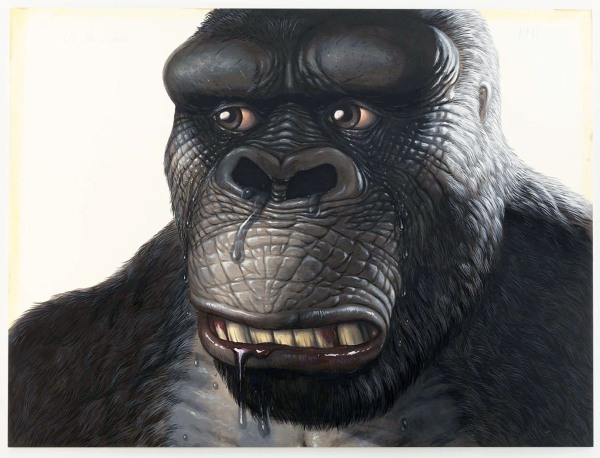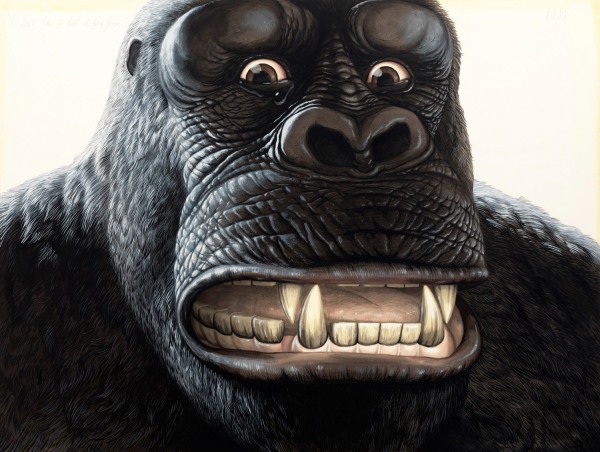Walton Ford: I Don't Like To Look At Him, Jack. It Makes Me Think Of That Awful Day On The Island
-
-
Paul Kasmin Gallery is pleased to present an exhibition of nine new, large-scale watercolor paintings by Walton Ford, on view for the first time, at 293 Tenth Avenue.
These nine paintings are grouped into two series of work: one comprising three portraits of King Kong; the other a six-part meditation on a passage from the memoirs of the ornithologist John James Audubon (1785-1851). Both series were painted in 2011, and are consistent with Ford’s practice of expanding the visual language and narrative scope of traditional natural history painting.
The first series, presenting three huge portraits of King Kong, is based on the 1933 movie co-directed by Merian C. Cooper and Ernest B. Schoedsack. As Ford explains, “The depression era Kong was misshapen, not modeled on any living ape. He has an odd, ugly, shifting charisma like Cagney, Edward G. Robinson, or Bogart. Naturally, his woman screamed in terror. She continued screaming throughout their time together. The grief of the original Kong is the grief of the unloved, and like Humbert Humbert or Frankenstein, the grief of the unlovable. In 1933, Fay Wray says words that would break any suitor's heart. She shrinks from the chained Kong and tells her human lover, ‘I don't like to look at him...’ Since Kong is a Hollywood tough guy, he covers up his heartbreak with violence and anger. These paintings are about Kong's heartbreak. I wanted to reveal the monster's grief, his enormous sadness, the sorrow that the original Kong kept hidden from view.”
-
Ford’s second series, which depicts a monkey capturing and strangling a parrot, was inspired by an unsettling passage from Audobon’s memoirs. Describing a childhood memory, Audobon writes:: “…My mother had several beautiful parrots and some monkeys; one of the latter was a full-grown male of a very large species. One morning, while the servants were engaged in arranging the room I was in, ‘Pretty Polly’ was asking for her breakfast as usual, ‘Du pain au lait pour le perroquet Mignonne,’ the man of the woods probably thought the bird presuming upon his rights in the scale of nature; be this as it may, he certainly showed his supremacy in strength over the denizen of the air, for, walking deliberately and uprightly toward the poor bird, he at once killed it, with unnatural composure. The sensations of my infant heart at this cruel sight were agony to me. I prayed the servant to beat the monkey, but he, who for some reason preferred the monkey to the parrot, refused. I uttered long and piercing cries, my mother rushed into the room, I was tranquillized, the monkey was forever afterward chained, and Mignonne buried with all the pomp of a cherished lost one. This made, as I have said, a very deep impression on my youthful mind.”
Ford’s work illuminates the strange, savage moments that occur at the intersection of human culture and the natural world. While human figures rarely appear in Ford’s paintings, their presence is always implied. Although monkeys, parrots and King Kong are the protagonists of the paintings, they exist only in the context of stories created and controlled by human beings.
Life-sized and impeccably detailed, Ford’s watercolors connote an old-master style, reminiscent of nineteenth-century artists’ portrayals of nature and animals. With exceptional accuracy, the paintings convey the artist’s art-historical and scientific knowledge, while also suggesting analogies between the past and the present day.
-
Works
-
About the Artist

Photo by Charlie Rubin. All artwork © Walton Ford
-
Join our Newsletter
* denotes required fields
We will process the personal data you have supplied in accordance with our privacy policy (available on request). You can unsubscribe or change your preferences at any time by clicking the link in our emails.
-
Explore
-
Explore
- Diana Al-Hadid
- Alma Allen
- Theodora Allen
- Sara Anstis
- Ali Banisadr
- Tina Barney
- Judith Bernstein
- JB Blunk
- Mattia Bonetti
- William N. Copley
- Cynthia Daignault
- Ian Davenport
- Max Ernst
- Liam Everett
- Leonor Fini
- Barry Flanagan
- Walton Ford
- Jane Freilicher
- vanessa german
- Daniel Gordon
- Alexander Harrison
- Elliott Hundley
- Robert Indiana
- Lee Krasner
- Les Lalanne
- Matvey Levenstein
- Lyn Liu
- Robert Motherwell
- Jamie Nares
- Nengi Omuku
- Robert Polidori
- Jackson Pollock
- Elliott Puckette
- Alexis Ralaivao
- George Rickey
- James Rosenquist
- Mark Ryden
- Jan-Ole Schiemann
- Joel Shapiro
- Bosco Sodi
- Dorothea Tanning
- Naama Tsabar
- Bernar Venet











